2) Wenzhou Marine Center, Ministry of Natural Resources, Wenzhou 325000, China;
3) Observation and Research Station of Yangtze River Delta Marine Ecosystems, Ministry of Natural Resources, Zhoushan 316000, China;
4) Key Laboratory of Marine Ecological Monitoring and Restoration Technologies, Ministry of Natural Resource, Shanghai 201206, China
Red tide is an abnormal phenomenon characterized by the rapid growth and reproduction of microorganisms in the ocean, which causes the disruption of marine ecosystems (Yu and Chen, 2019). Red tide, scientifically named 'algal blooms', leads to seawater discoloration, with research indicating that various dominant algal species can cause dissimilar color changes (Berdalet et al., 2017). In recent years, the incidence and duration of algal bloom events have substantially increased, which is attributed to the rapid deterioration of coastal environments owing to eutrophication. This deterioration was mainly brought about by the combined effects of human activities and climate change (Zhang et al., 2012; Glibert et al., 2018; Yu and Chen, 2019), which placed greater pressure on the marine ecosystems and created a considerable threat to coastal economic development (Yu et al., 2017; Yan et al., 2022). China has an encouragingly developed marine economy, a vast marine territory, an extensive coastline, and numerous harbors. However, the exploitation of marine resources and the growth of the marine economy are immensely influenced by frequent, severe algal bloom incidents (Chen et al., 2023). Consequently, to facilitate marine economic production, improving the monitoring and early warning technologies for algal bloom events is vital.
Traditional algal bloom event observation capabilities, including the ship-based observation of in-situ hydrological environmental parameters, the collection and analysis of seawater samples, and the identification of dominant algal species, have remarkably improved (Guan et al., 2022). In addition, satellite remote sensing technology, depending on the close relationship between chlorophyll-a concentration and algal cell density as well as the underlying mechanism of algal blooms causing seawater discoloration, has considerably improved the long-term monitoring and early warning of algal bloom events (Stumpf and Tomlinson, 2005; Shen et al., 2012). Researchers have tailor-made algal bloom inversion algorithms for diverse water types. For instance, Tao et al. (2005) presented the algal bloom ratio (RAB) algorithm for Class Ⅱ water bodies characterized by suspended sediment, which improved the differentiation of algal bloom occurrences in China's coastal waters, mostly in Class Ⅱ water bodies (Li et al., 2022). Satellite remote sensing presents a more comprehensive, real-time method for the observation and early warning of algal blooms compared with traditional methods. However, it still has limitations in identifying algal bloom events below the sea surface or under cloud cover. As a result, the development of marine ecological numerical models to augment the prediction and early warning capabilities of algal bloom events has evolved into a novel research area (Wang et al., 2016).
Existing algal bloom prediction models are grouped into three: ecosystem numerical models based on the mechanism of harmful algal blooms, empirical regression models, and machine learning models driven by big data analytics (McGillicuddy, 2010; Zhu et al., 2023). Ecosystem model building depends on the exact, comprehensive investigation of the mechanism of algal bloom incidents. For example, Chen et al. (2019) successfully replicated the seasonal ecological changes in the central East China Sea using GOTM-FABM-ERSEM, a 1D physical ecological representation. However, in practical applications, ecosystem models display limitations, such as computational complexity and implementation challenges. Moreover, they are more region-specific compared with hydrodynamic models, which constrains their flexibility in application (Kim et al., 2014). By contrast, algal bloom events are affected by a combination of meteorology, hydrology, biology, chemistry, and human factors, resulting in complex, nonlinear changes. These complexities are challenging to capture for regression models, often resulting in substantial errors in practical applications (Gilbert, 2017; Xie et al., 2019).
With the rapid advancement of big data science, statistical models ingrained in artificial intelligence and deep learning networks have achieved widespread use in algal bloom prediction research due to their exceptional data parallel processing, adaptability, and fault tolerance (Qin et al., 2017; Ding et al., 2022; Guan et al., 2022). Scholars have performed various experiments during the optimization of machine learning models for algal bloom prediction. Kim et al. (2023) incorporated feature engineering and attention mechanisms into deep learning models and made the daily forecasts of harmful algal blooms possible without any manipulation. Given the optical complexity of coastal water bodies, Zhu et al. (2023) achieved the time series prediction of chlorophyll concentration and water quality parameters based on a new hybrid CVXS model. To forecast the spatial changes of detrimental algal blooms, Li et al. (2024) established the HBGC-CNN model integrating satellite observations, numerical models, and machine learning; this new model can retain spatiotemporal information compared with time series forecasts. However, extra input variables can reduce the analytical accuracy and application efficiency of the model (Liu and Tang, 2012; Su et al., 2015). Shin et al. (2020) emphasized that the choice of variables and prediction time steps is vital for elevating model predictive performance, as shown by the comparative experimental results. As a result, various approaches for selecting variables have been offered to improve the accuracy of algal bloom prediction models. Yu et al. (2021) attained a 67.58% accuracy in predicting short-term algal bloom by utilizing correlation coefficient methods to determine environmental factors that are strongly correlated with algal bloom occurrence as variables. However, these approaches always depend on the numerical relationship between the target variable and the input variables, which reduces the interpretability of the obtained prediction results and deters the progression of machine learning prediction methods for detrimental algal blooms (Ibrahim et al., 2019; Kim et al., 2023). To improve the interpretability of algal bloom prediction models, the spring algal blooms in the Wenzhou sea area of Zhejiang were examined in this study. Critical environmental factors affecting the outbreak of algal blooms were determined through an in-depth analysis of the outbreak mechanism utilizing data from three ecological buoys deployed in the area (Lin et al., 2023; Manik et al., 2023). Considering the remarkable association between chlorophyll concentration and algal cell density, chlorophyll concentration was selected as the output factor (Stumpf and Tomlinson, 2005). A long short-term memory (LSTM) neural network was used to establish the prediction model for spring algal blooms in the coastal waters of Zhejiang. This method not only provided a reference for algal bloom prevention and control in the Zhejiang sea area but also strengthened the interpretability of algal bloom prediction models.
2 Study Area and Data 2.1 Study AreaWenzhou, located in the southeastern part of Zhejiang Province, borders the East China Sea to its east. The region covers a total water area of 8649 km2, highlighting a 514-km-long coastline and more than 700 islands. Wenzhou has grown a robust marine economy, taking advantage of its rich marine resources and distinct ecosystems. However, it also faces many marine disasters, notably algal blooms. Statistical data show that from 2007 to 2016, Wenzhou's coastal waters suffered 63 algal bloom events, and one-third of these were toxic. The cumulative affected area reached 5197 km2, causing immense aquaculture casualties and substantial economic losses (Gao et al., 2017).
2.2 Buoy DataThe buoy data used were taken from the Wenzhou Marine Environmental Monitoring Center of the Ministry of Natural Resources. These data covered spring 2016 to 2022 and were gathered from three buoy locations: Nanji, Yuliao, and Dongtou. The data were logged at 15-min intervals and encompassed parameters including temperature, salinity, chlorophyll concentration, pH value, dissolved oxygen concentration (DO), dissolved oxygen saturation (DOS), turbidity, and conductivity. The chlorophyll concentration data recorded by these buoys were the focus of this study. The locations of the ecological buoy deployments are shown in Fig.1, and detailed information is presented in Table 1.
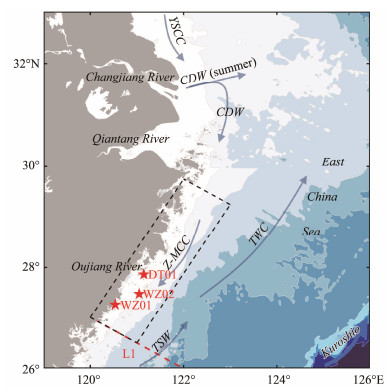
|
Fig. 1 Wenzhou coastal waters and the position of buoys. |
|
|
Table 1 Specific information on the ecological buoys |
The reanalysis and forecast data, which are crucial in mechanism analysis and operational forecasting, were sourced from the European Centre for Medium-Range Weather Forecasts (ECMWF, https://www.ecmwf.int/). ERA5, the reanalysis dataset, consists of a comprehensive global climate reanalysis of ocean, atmospheric, and land climate changes from January 1950 to the present. ERA5 has a spatial resolution of 0.25˚ and offers atmospheric field data at 137 distinct levels; hence, it is one of the most widely used reanalysis datasets.
In 2022, the ECMWF started publicly providing a diverse array of forecast data that included a range of forecast products. Ten-meter wind field data and sea surface temperature field data from their high-resolution forecast offerings were utilized in this study.
2.4 Remote Sensing DataThe satellite remote sensing data were merged with buoy observations to expand the analysis of spring algal bloom incidents. Ocean color data, taken from the Visible Infrared Imaging Radiometer Suite with a maximum spatial resolution of 375 m and a temporal resolution of 4 times per day, enabled broad coverage and continuous observation of algal bloom events in the coastal waters near Wenzhou.
To obtain the spatiotemporal variations of spring algal blooms precisely, the approach suggested by Tao et al. (2015) was used to calculate the RAB index using satellite observation data, as shown in Eq. (1). A threshold derived from this index was used, and information on spring algal bloom events and their coverage in the target marine areas was extracted. In relation to chlorophyll concentration analyses, using this index for spring algal bloom event analysis results in more accurate, faster access to relevant information (Li et al., 2022).
| $ {R_{AB}} = \frac{{{R_{rs}}(555)}}{{{R_{rs}}(531)}} . $ | (1) |
An artificial intelligence prediction model for spring algal bloom occurrence in a target marine area was created using the LSTM neural network (Lee and Lee, 2018). The detailed processes of the model construction are illustrated in Fig.2.
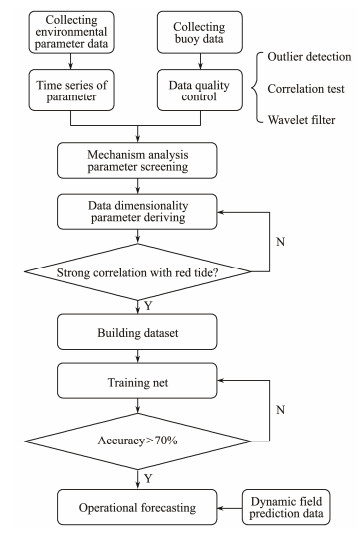
|
Fig. 2 Wenzhou spring algal bloom forecast model construction. |
The dataset used for training the forecast model of Wenzhou spring algal blooms was composed of the chlorophyll concentration logged by buoys as the output and the corresponding reanalysis data variables as the input. First, the chlorophyll concentration data were subjected to strict quality control and precise selection to ensure quality. Then, the time series data of the required parameters were extracted from the reanalysis data. The chlorophyll concentration time series often comprises numerous extreme values or non-numbers, which is attributed to the operational status of the ecological buoy. Thus, the initial step involved removing these values in accordance with the three-sigma rule. Subsequently, abnormal values in the chlorophyll concentration time series were excluded using the abnormal data identification method (Zhang et al., 2020). Finally, the desired data were derived by screening the time series. In addition, choosing buoy data that accurately represented the existence of spring algal blooms in the monitoring area was vital. To improve the interpretability of the forecast model, input variables were carefully chosen, and additional ones were derived based on the mechanisms of spring algal blooms. The input variables were controlled based on the analysis of their correlation with the chlorophyll concentration time series.
3.2 Variable Selection for InputThe mechanism of the first spring algal bloom outbreak near Wenzhou was explored. The data regarding three spring algal bloom events from 2020 to 2022 were extracted from ecological buoy data, and the key characteristics of parameter changes during the spring algal bloom outbreak periods were examined to determine the principal environmental parameters affecting the spring algal bloom events.
Figs.3 – 5 exhibit the changes in ecological parameters, including chlorophyll concentration, temperature, and salinity, during the first spring algal bloom events from 2020 to 2022. Chlorophyll concentration, a key indicator of spring algal bloom events, rapidly increased in the three events. The chlorophyll concentration in 2022 was notably different, varying by an order of magnitude from the two previous years; this result implied the dominance of dinoflagellates over the diatom species observed in the earlier events. Concurrent with the spring algal bloom events, a remarkable rapid change in temperature was observed among the recorded ecological parameters. Seawater temperature increased before and after the spring algal bloom outbreak, emphasizing the great correlation between temperature and spring algal bloom events. As stated by previous research (Wang et al., 2001; Iriarte and Purdie, 2004; Kim et al., 2004), optimal seawater temperature facilitates the growth and reproduction of phytoplankton, concluding in spring algal bloom outbreaks. Hence, sea surface temperature is a key factor in the outbreak of spring algal bloom events near Wenzhou and deserves to be considered in the construction of future machine learning models.
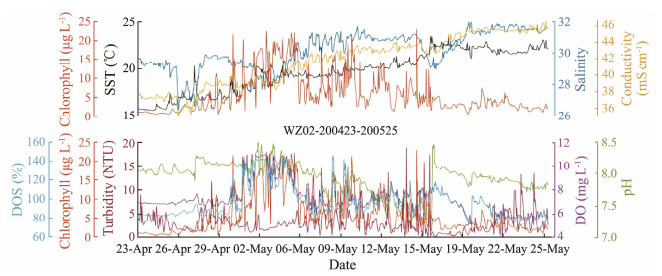
|
Fig. 3 Parameter changes of the ecological buoy in Nanji from April 23 to May 25, 2020. |

|
Fig. 4 Parameter changes of the ecological buoy in Nanji from April 22 to May 19, 2021. |
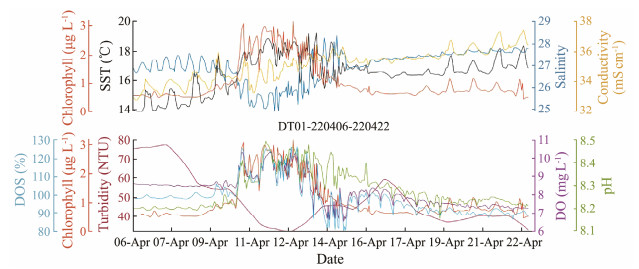
|
Fig. 5 Parameter changes of the ecological buoy in Dongtou from April 6 to April 22, 2022. |
Fig.6 presents the wind field variations from 2020 to 2022 during spring. The analysis of the changes in wind direction revealed a noticeable trend: weakening north winds and strengthening south winds around the time of the first spring algal bloom outbreaks from 2020 to 2022. In 2020 and 2021, the north and south winds alternated before the first spring algal bloom outbreak; south winds prevailed during the outbreak, underscoring the effect of wind field transitions on spring algal bloom outbreaks. In 2022, a weaker wind field dominated by south winds preceded the spring algal bloom outbreak, but a remarkable north wind event was observed during the spring algal bloom. As a result, this specific spring algal bloom had a shorter duration. The correlation between wind direction changes and the onset and duration of spring algal bloom events clearly illustrated the substantial positive influence of wind direction shifts, specifically the intensity of south winds, on spring algal bloom outbreaks.
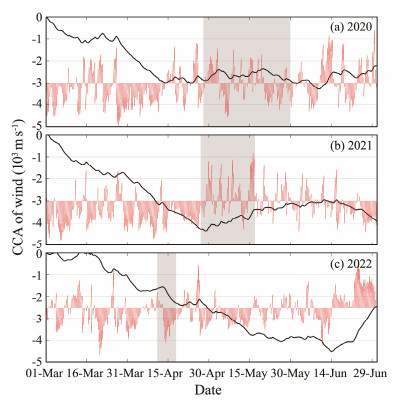
|
Fig. 6 Cumulative changes in the wind field and coastal component in the Wenzhou nearshore area from 2020 to 2022. The semitransparent gray intervals denote the periods of the first spring algal bloom outbreaks reported. The red arrows signify the vector average changes in the nearshore wind field in Wenzhou. The black curve represents the cumulative changes in the coastal component of the wind field from March 1. |
A new variable, named the coastal component accumulation (CCA) of wind, was defined to denote the cumulative effect of the wind field's coastal component on the offshore direction over time, as shown in Eq. (2).
| $ CCA = \int_{{t_0}}^t {{V_{{\text{coastal wind}}}}} . $ | (2) |
The effect of wind on seawater is continuous, long-term, and subject to a degree of lag, so CCA was introduced to clarify the long-term influence of wind on seawater. Each spring algal bloom outbreak coincided with a period of CCA plateau, which suggested a lack of dominant wind direction and weak wind speeds. As a result, the wind field plays a key role in the outbreak of spring algal bloom in the Wenzhou nearshore area; hence, the wind field is recommended to be considered in the creation of subsequent machine learning models.
Among other parameters recorded by the ecological buoy, conductivity substantially changed during spring algal bloom. However, conductivity was not discussed independently because its information overlapped with that of salinity. pH value and dissolved oxygen levels noticeably fluctuated before and after the spring algal bloom. The pH value rose during the initial stages of spring algal bloom and subsequently decreased, reflecting the trends in dissolved oxygen content and saturation. However, the acquisition of these parameters posed challenges, making them less feasible for practical application in the spring algal bloom prediction model for the Wenzhou waters. Turbidity did not exhibit consistent trends during spring algal bloom, so it was not considered.
In conclusion, the analysis verified that the fluctuations in sea surface temperature and wind field are fundamental factors in the outbreak of spring algal bloom in Wenzhou. The reanalysis data for these factors were utilized, and the derived parameters, including temperature change rate, coastal wind change rate, offshore wind change rate, wind speed, cumulative wind speed, cumulative coastal wind field, and cumulative offshore wind field, were calculated. The correlation coefficients between these parameters and the chlorophyll concentration time series were examined to determine the final variables involved in constructing the model.
3.3 Model ValidationFollowing extensive testing, the final model variables were established as follows: the Adam gradient descent algorithm was used for the loss function. The training covered 1000 iterations with an initial learning rate of 0.005 and a learning rate decay factor of 0.1. The model comprised 10 hidden layers, and training terminated when no further change was observed in the loss. The model demonstrated excellent predictive performance on the training set and achieved the following statistical metrics: a coefficient of determination (R2) of 0.99, a root mean square error (RMSE) of 0.58, a mean absolute error (MAE) of 0.39, and a mean bias error (MBE) of 0.02. For the test set, the model achieved an R2 of 0.80, an RMSE of 3.33, an MAE of 2.34, and an MBE of 0.49 (Fig.7). These results solidly attested to the model's robust performance.
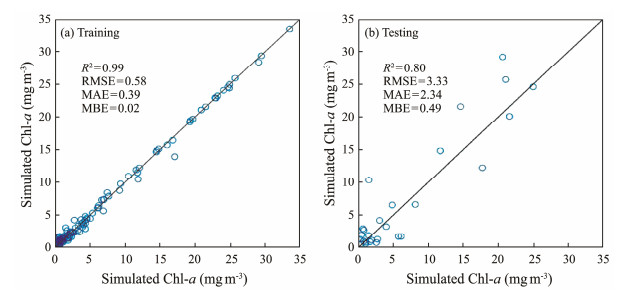
|
Fig. 7 Model training performance. |
To verify the forecasting accuracy during the model training phase, a retrospective dataset for spring algal bloom events in Wenzhou covering 2016 to 2019 utilizing the ERA5 reanalysis dataset was developed. The model's effectiveness was determined by comparing its retrospective results with satellite imagery and onsite observations of spring algal bloom. The retrospective results are presented in Fig.8.

|
Fig. 8 Retrospective prediction results for spring algal bloom events in 2016 – 2019. |
The retrospective prediction results for the spring algal bloom covering 2016 – 2019, especially from April to May, considerably agreed with the buoy observations. To quantify the model's performance further, three metrics, namely, the probability of detection (POD), the false alarm ratio (FAR), and the probability of correct result (POCR), were utilized as outlined by Anderson et al. (2010) to evaluate the model's retrospective predictions. These metrics are defined as follows:
| $ POD = \frac{{{D_{{\text{correct hits}}}}}}{{{D_{{\text{correct hits}}}} + {D_{{\text{false negatives}}}}}}, $ | (3) |
| $ FAR = \frac{{{D_{{\text{false positives}}}}}}{{{D_{{\text{correct hits}}}} + {D_{{\text{false negatives}}}} + {D_{{\text{false positives}}}}}}, $ | (4) |
| $ POCR = \frac{{{D_{{\text{correct hits}}}} + {D_{{\text{correct negatives}}}}}}{N}, $ | (5) |
where Dcorrect hits denotes the number of correct bloom predictions, Dfalse negatives is the number of bloom observations incorrectly predicted by the model as nonblooms, Dfalse positives is the number of nonbloom observations incorrectly predicted by the model as blooms, Dcorrect negatives is the number of accurately predicted nonbloom observations. The retrospective prediction performance metrics are presented in Table 2.
|
|
Table 2 Statistics of retrospective prediction of the model in the spring of 2016 – 2019 |
The 24-h forecast results were remarkably more accurate than those of longer horizons, and the accuracy improved with shortening the forecast horizon. During the May 2019 spring algal bloom event, the high POCR (81.71%) for the 24-h forecast underscored the consistency of the model's predictions with the actual observations. Thus, the accuracy of the Wenzhou spring algal bloom forecasting model developed in this study was confirmed.
4 Results and DiscussionThe development of the Wenzhou spring algal bloom forecast model involved utilizing historical algal bloom samples from three ecological buoys near Wenzhou and the ECMWF forecast data. A quality control screening of the spring data from the three ecological buoys spanning 2020 – 2022 was performed, and 159 valid spring algal bloom data samples were obtained. Mechanism analysis identified environmental factors with a decisive role in the outbreak of spring algal bloom events in Wenzhou, which were then selected as the input variables for the model. Then, buoy data and corresponding reanalysis input variable data from the same period were merged to establish the training dataset for the model. The Wenzhou spring algal bloom forecast model was trained with the dataset using an LSTM neural network and then used to generate operational forecasts for algal bloom occurrences the following day based on ECMWF environmental parameter forecast data.
For the operational deployment of the spring algal bloom forecasting model in Wenzhou, the ECMWF forecast data were processed into a time series format for use as the model input. The model computed and output the chlorophyll concentration forecasts and subsequently compared them with a spring algal bloom threshold of 10 mg m−3 to confirm the chance of spring algal bloom events. The model is presently in the operational trial phase but has shown substantial practical value. Furthermore, the retrospective assessments of spring algal bloom occurrences from 2016 to 2019 using the model underscored its reliability and areas for further improvement.
4.1 Operational Forecast Results for 2023Throughout the operational and trial phase, a forecast dataset was compiled utilizing the ERA5 reanalysis data in conjunction with the ECMWF forecast data. The spring algal bloom forecasting model was utilized to predict the next-day changes in chlorophyll concentration, thus helping assess spring algal blooms. In the spring of 2023, this model was applied and successfully forecasted spring algal blooms that happened at the end of April and early May, as illustrated in Figs.9 – 10.
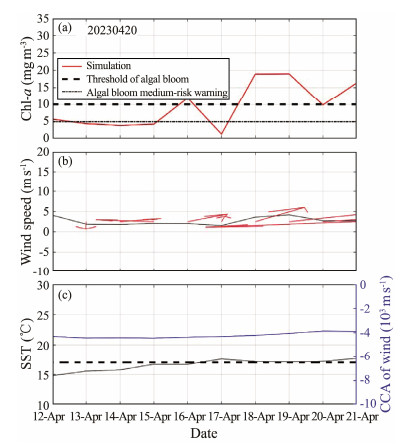
|
Fig. 9 Forecast results for April 20, 2023. |
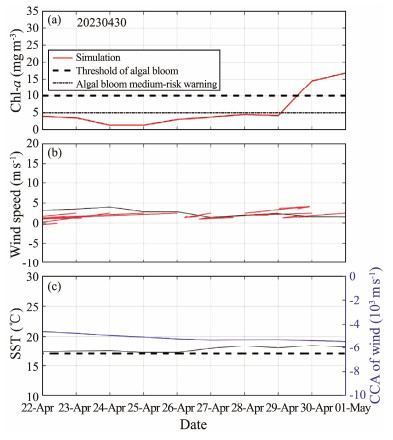
|
Fig. 10 Forecast results for April 30, 2023. |
Correlating the forecast results with temperature and wind field changes revealed that the model's spring algal bloom warning agreed with sea surface temperature exceeding the SST threshold, a weakening wind field, and the CCA curve reaching a plateau phase. This alignment corroborated the previously identified characteristics of the influencing factors of spring algal bloom near Wenzhou and offered insights into the model's predictive accuracy.
The satellite observation data depicted in Fig.11 were utilized, and the RAB image was determined. Observations revealed a spring algal bloom event in the coastal waters near Cangnan, Wenzhou, on April 21 and a second event near Nanji Island around May 1. These instances were confirmed by in-situ observations from the Wenzhou Marine Center. This consistency with the forecast results of the spring algal bloom prediction model corroborated the reliability of the method used for selecting model input variables, which was based on the mechanism of spring algal bloom occurrence. Moreover, this outcome strengthened the interpretability of the model's output results and emphasized its practical efficacy and application value.
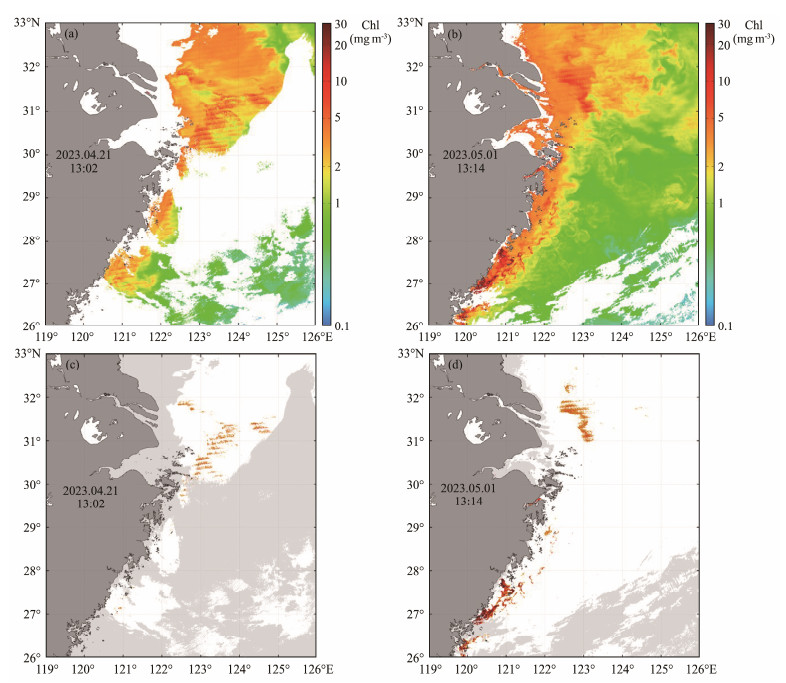
|
Fig. 11 Images of chlorophyll concentration (top) and RAB (bottom) on April 21 and May 1, 2023. |
Neural network-based spring algal bloom prediction models often contend with the challenge of opaque mechanisms. An analysis of the mechanisms behind spring algal blooms was preemptively conducted in this study, and environmental parameters with strong causal relationships with these events were selected for use as the model inputs. This approach remarkably improved the interpretability of the model's output results but narrowed its scope of application. Table 3 presents the statistical data on the spring algal blooms between 2016 and 2022.
|
|
Table 3 Statistics of field observations of spring algal blooms in Wenzhou nearshore from 2016 to 2022 |
Spring algal bloom encompasses a wide spectrum, which is influenced by the dominant causative algal species, leading to a classification into diverse spring algal bloom phenomena. Algal species present distinct growth and proliferation, yielding a range of triggering mechanisms for several types of spring algal blooms. In the current study, the model's training dataset encompassed data for 2020 – 2022, and retrospective analyses targeted spring algal bloom occurrences for 2016 – 2019. During 2020 – 2022, spring algal blooms were predominantly attributed to Prorocentrum donghaiense, in stark contrast to the wider variety of species recorded during 2016 – 2019. This constraint substantially hindered the model's efficacy in accurately forecasting spring algal blooms occurring from a multitude of algal species, as shown in Fig.8 and Table 3. Xiao et al. (2018) deduced from a 14-year dataset that diatom blooms in the East China Sea generally manifest under conditions of low-temperature and high-nutrient levels, while environments characterized by low phosphate and elevated nitrogen-phosphorus ratios are conducive to dinoflagellate blooms. Moreover, Recknagel's (1997) research on the prediction of five blue-green algal species indicated that the inclusion of a broader array of spring algal bloom events in the training dataset substantially improves predictive accuracy. Consequently, the observed variation in algal species between the periods of 2016 – 2019 and 2020 – 2022 presented an immense challenge in the application of spring algal bloom prediction methodologies.
The restricted availability of buoy data limited this study to a small subset of spring algal blooms, mainly those dominated by P. donghaiense. Consequently, the artificial intelligence model, developed for predicting spring algal blooms and trained on the buoy data, encountered challenges in accurately forecasting blooms instigated by diverse algal species, thus needing more extensive data.
4.3 Relationship with ENSO EventsChanges in the dominant algal species of spring algal bloom events in Wenzhou's nearshore waters from 2016 to 2022 remarkably influenced the accuracy of the spring algal bloom prediction model. The succession of dominant algal species mirrored the distinct responses of various algal species to environmental changes. According to Wang et al. (2022), phytoplankton communities are largely influenced by variations in water temperature and precipitation. This study aimed to optimize the spring algal bloom prediction model further by investigating the effect of large-scale climate change on the succession of dominant algal species in spring algal bloom events.
ENSO events represent quasiperiodic phenomena involving ocean-atmosphere interaction in the tropical Pacific, described by oscillation in winds and sea surface temperatures. In the ocean, ENSO manifests as the El Niño-La Niña phenomenon, typically gauged by the NINO3.4 index. ENSO events exert a remarkable effect on low-latitude atmospheric circulation, thereby influencing local circulation patterns and environmental features, including sea surface temperature, in nearshore waters. Research revealed that during the positive phase of ENSO or El Niño events, sea surface temperatures in the East China Sea Kuroshio region increase. Conversely, during the negative phase or La Niña events, cooling occurs (Sun, 2009). Variable temperature conditions are crucial in influencing the growth and decline of spring algal bloom organisms. In the Zhoushan sea area, P. donghaiense shifted to Skeletonema costatum with rising temperatures during the May to October algal bloom outbreak in 2002 (Wang and Huang, 2003). Shen (2014) demonstrated through a series of laboratory experiments that the optimal growth temperature for P. donghaiense is lower than that for Karenia mikimotoi. Statistical data spanning 2001 to 2010 show that warm seawater conditions favor K. mikimotoi algal blooms, whereas cold conditions are conducive to P. donghaiense blooms. Studies have also confirmed that the Heterosigma akashiwo also thrives in warm environments (Yang, 2021). Considering the fluctuations in the NINO3.4 index from 2016 to 2022 depicted in Fig.12, the index was in a positive phase during spring and summer from 2016 to 2020, causing increased sea surface temperatures in the nearshore waters of Zhejiang. This condition promoted the proliferation of K. mikimotoi and H. akashiwo, causing algal blooms. By contrast, the NINO3.4 index remained in a prolonged negative phase from 2020 to 2022, which largely indicated a La Niña event. These low-temperature conditions favored the outbreak of P. donghaiense blooms, which was consistent with the statistical findings of spring algal bloom in the nearshore waters of Zhejiang, as shown in Table 3. Thus, incorporating the effect of large-scale climate change into spring algal bloom prediction models is clearly advantageous for enhancing prediction accuracy.
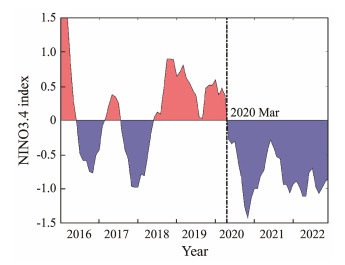
|
Fig. 12 Changes in the NINO3.4 index from 2016 to 2022. |
An artificial intelligence algal bloom prediction model for the P. donghaiense blooms in the East China Sea during spring was developed based on the historical monitoring data from three ecological buoys in the nearshore waters of Wenzhou from 2016 to 2022. This model incorporated the reanalysis of temperature and wind data for the same period to build its training dataset and utilized an LSTM neural network for prediction. In its operational phase in 2023, the model accurately predicted spring algal bloom events in late April and early May, emphasizing its immense application potential. Unlike traditional artificial intelligence algal bloom prediction models, this model adopted an alternative approach to enhance interpretability, considering the challenges in deploying and maintaining ecological buoys and the complexity of data quality control. The critical roles of temperature and wind field changes in nearshore spring algal bloom were examined. The model achieved effective results during its operational phase and presented promising potential for further advancement and application.
A retrospective assessment of spring algal bloom in Zhejiang's nearshore waters was conducted from 2016 to 2019 using this model. The results revealed that various algal species showed distinct responses to environmental factors. In spring 2019, the dominant species in two successive algal bloom events were H. akashiwo and P. donghaiense. The retrospective analysis accurately recreated the P. donghaiense algal bloom but failed to capture the outbreak of H. akashiwo. This outcome can be attributed to the fact that the dominant species of algal bloom during spring 2020 – 2022, which informed the construction of the training dataset, were primarily P. donghaiense. The machine learning approach focused on the outbreak mechanism of P. donghaiense. This outcome also suggested that the response mechanisms of P. donghaiense and H. akashiwo to environmental factors varied substantially, influencing the model's results. Furthermore, the succession of varying algal species was influenced by large-scale climate changes. Thus, investigating the mechanisms of various algal species and developing differentiated prediction models will be a crucial focus in future algal bloom prediction research.
AcknowledgementsThe authors express their gratitude to the Zhejiang Provincial Natural Science Foundation of China (No. LY21D060003), the Project of State Key Laboratory of Satellite Ocean Environment Dynamics, Second Institute of Oceanography, MNR (No. SOEDZZ2103), the National Natural Science Foundation of China (No. 42076216), and the Open Research Fund of the Key Laboratory of Marine Ecological Monitoring and Restoration Technologies, MNR (No. MEMRT202210).
Author Contributions
All authors contributed to the study conception and design. Material preparation, data collection were performed by Zhao Zhang, Dongming Gu and Liansong Liang. Data analysis and the draft of the manuscript was written by Min Bao, Guoqiang Huang and Bangyi Tao, and all authors commented on previous versions of the manuscript. All authors read and approved the final manuscript.
Data Availability
All data generated and analyzed during this study are included in this published article and its additional files.
Declarations
Ethics Approval and Consent to Participate
This article does not contain any studies with human participants or animals performed by any of the authors.
Consent for Publication
Informed consent for publication was obtained from all participants.
Conflict of Interests
The authors declare that they have no conflict of interests.
Anderson, C. R., Sapiano, M. R. P., Prasad, M. B. K., Wen, L., Tango, P. J., Brown, C. W., et al., 2010. Predicting potentially toxigenic Pseudo-nitzschia blooms in the Chesapeake Bay. Journal of Marine Systems, 83(3-4): 127-140. DOI:10.1016/j.jmarsys.2010.04.003 (  0) 0) |
Berdalet, E., Kudela, R., Urban, E., Enevoldsen, H., Banas, N. S., Bresnan, E., et al., 2017. Global HAB: A new program to promote international research, observations, and modeling of harmful algal blooms in aquatic systems. Oceanography, 30(1): 70-81. (  0) 0) |
Chen, C., Liang, J., Yang, G., and Sun, W., 2023. Spatio-temporal distribution of harmful algal blooms and their correlations with marine hydrological elements in offshore areas, China. Ocean & Coastal Management, 238: 106554. DOI:10.1016/j.ocecoaman.2023.106554 (  0) 0) |
Chen, J., Ge, J., and Bellerby, R., 2019. Numerical simulation of pelagic ecosystem's seasonal vibration in the central East China Sea. Journal of East China Normal University (Natural Science), 6: 153-168 (in Chinese with English abstract). DOI:10.3969/j.issn.1000-5641.2019.06.015 (  0) 0) |
Ding, W. X., Zhang, C. Y., and Shang, S. P., 2022. The early assessment of harmful algal bloom risk in the East China Sea. Marine Pollution Bulletin, 178: 113567. DOI:10.1016/j.mar-polbul.2022.113567 (  0) 0) |
Gao, J. Z., Liu, Y. L., Lin, Y., and Wang, H. J., 2017. Analysis on characteristics of red tide disaster in Wenzhou coastal waters during the last 10 years. Transactions of Oceanology and Limnology, 4: 86-90 (in Chinese with English abstract). DOI:10.13984/j.cnki.cn37-1141.2017.04.010 (  0) 0) |
Glibert, P. M., 2017. Eutrophication, harmful algae and biodiversity – Challenging paradigms in a world of complex nutrient changes. Marine Pollution Bulletin, 124(2): 591-606. DOI:10.1016/j.marpolbul.2017.04.027 (  0) 0) |
Glibert, P. M., Al-Azri, A., Allen, J. I., Bouwman, A. F., Beusen, A. H. W., Burford, M. A., et al., 2018. Key questions and recent research advances on harmful algal blooms in relation to nutrients and eutrophication. Global Ecology and Oceanography of Harmful Algal Blooms, 232: 229-259. DOI:10.1007/978-3-319-70069-4_12 (  0) 0) |
Guan, W. B., Bao, M., Lou, X. L., Zhou, Z. X., and Yin, K. D., 2022. Monitoring, modeling and projection of harmful algal blooms in China. Harmful Algae, 111: 102164. DOI:10.1016/j.hal.2021.102164 (  0) 0) |
Ibrahim, M., Louie, M., Modarres, C., and Paisley, J., 2019. Global explanations of neural networks: Mapping the landscape of predictions. Proceedings of the 2019 AAAI/ACM Conference on AI, Ethics, and Society. Hawaii, 279-287, DOI: 10.1145/3306618.3314230.
(  0) 0) |
Iriarte, A., and Purdie, D. A., 2004. Factors controlling the timing of major spring bloom events in an UK south coast estuary. Estuarine, Coastal and Shelf Science, 61(4): 679-690. DOI:10.1016/j.ecss.2004.08.002 (  0) 0) |
Kim, D. I., Matsuyama, Y., Nagasoe, S., Yamaguchi, M., Yoon, Y. H., and Oshima, Y., 2004. Effects of temperature, salinity and irradiance on the growth of the harmful red tide dinoflagellate Cochlodinium polykrikoides Margalef (Dinophyceae). Journal of Plankton Research, 26(1): 61-66. DOI:10.1093/plankt/fbh001 (  0) 0) |
Kim, T. H., Shin, J., and Cha, Y. K., 2023. Incorporation of feature engineering and attention mechanisms into deep learning models to develop an early warning system for harmful algal blooms. Journal of Cleaner Production, 414: 137564. DOI:10.1016/j.jclepro.2023.137564 (  0) 0) |
Kim, Y. H., Im, J., Ha, H. K., Choi, J. K., and Ha, S., 2014. Machine learning approaches to coastal water quality monitoring using GOCI satellite data. GIScience & Remote Sensing, 51(2): 158-174. DOI:10.1080/15481603.2014.900983 (  0) 0) |
Lee, S., and Lee, D., 2018. Improved prediction of harmful algal blooms in four major South Korea's Rivers using deep learning models. International Journal of Environmental Research and Public Health, 15(7): 1322. DOI:10.3390/ijerph15071322 (  0) 0) |
Li, C. P., Tao, B. Y., Liu, Y. L., Zhang, S. G., Zhang, Z., Song, Q. J., et al., 2022. Assessment of VIIRS on the identification of harmful algal bloom types in the coasts of the East China Sea. Remote Sensing, 14(9): 2089. DOI:10.3390/rs14092089 (  0) 0) |
Li, H., Li, X. R., Song, D. H., Nie, J., and Liang, S. K., 2024. Prediction on daily spatial distribution of chlorophyll-a in coastal seas using a synthetic method of remote sensing, machine learning and numerical modeling. Science of the Total Environment, 910: 168642. DOI:10.1016/j.scitotenv.2023.168642 (  0) 0) |
Lin, J., Liu, Q. Q., Song, Y., Liu, J. T., Yin, Y. X., and Hall, N. S., 2023. Temporal prediction of coastal water quality based on environmental factors with machine learning. Journal of Marine Science and Engineering, 11: 1608. DOI:10.3390/jmse11081608 (  0) 0) |
Liu, C., and Tang, D., 2012. Spatial and temporal variations in algal blooms in the coastal waters of the western South China Sea. Journal of Hydro-Environment Research, 6(3): 239-247. DOI:10.1016/j.jher.2012.02.002 (  0) 0) |
Manik, L. P., Puspasari, R., Riyanto, S., Albasri, H., Triharyuni, S., Yaman, A., et al., 2023. Utilizing knowledge bases in filtering IoT data to predict algal blooms. 2023 International Conference on Computer, Control, Informatics and Its Applications (IC3INA), 2023: 43-48, DOI: 10.1109/IC3INA60834.2023.10285783.
(  0) 0) |
McGillicuddy Jr., D. J., 2010. Models of harmful algal blooms: Conceptual, empirical, and numerical approaches. Journal of Marine Systems: Journal of the European Association of Marine Sciences and Techniques, 83(3-4): 105. DOI:10.1016/j.jmarsys.2010.06.008 (  0) 0) |
Qin, M., Li, Z., and Du, Z., 2017. Red tide time series forecasting by combining ARIMA and deep belief network. Knowledge-Based Systems, 125: 39-52. DOI:10.1016/j.knosys.2017.03.027 (  0) 0) |
Recknagel, F., 1997. ANNA-artificial neural network model for predicting species abundance and succession of blue-green algae. Hydrobiologia, 349: 47-57. DOI:10.1023/A:1003041427672 (  0) 0) |
Shen, A. L., 2014. Response mechanism of interspecies competition between Prorocentrum donghaiense and Karenia mikimotoi to the changes of seawater temperature. PhD thesis. East China Normal University (in Chinese with English abstract).
(  0) 0) |
Shen, L., Xu, H., and Guo, X., 2012. Satellite remote sensing of harmful algal blooms (HABs) and a potential synthesized framework. Sensors, 12: 7778-7803. DOI:10.3390/s120607778.1 (  0) 0) |
Shin, Y., Kim, T., Hong, S., Lee, S., Lee, E., Hong, S. W., et al., 2020. Prediction of chlorophyll-a concentrations in the Nakdong River using machine learning methods. Water, 12(6): 1822. DOI:10.3390/w12061822 (  0) 0) |
Stumpf, R. P., and Tomlinson, M. C., 2005. Chapter 12 – Remote sensing of harmful algal blooms. In: Remote Sensing of Coastal Aquatic Environments. Miller, R. L., et al., eds., Springer, Dordrecht, 277-2.
(  0) 0) |
Su, J. Q., Wang, X., Zhao, S. Y., Chen, B., Li, C. H., and Yang, Z. F., 2015. A structurally simplified hybrid model of genetic algorithm and support vector machine for prediction of chlorophyll a in reservoirs. Water, 7(4): 1610-1627. DOI:10.3390/w7041610 (  0) 0) |
Sun, N. N., 2009. Variations of sea surface temperature over Kuroshio in the East Sea and its relationship with El-Niño and global warming. PhD thesis. Ocean University of China (in Chinese with English abstract).
(  0) 0) |
Tao, B. Y., Mao, Z. H., Lei, H., Pan, D. L., Shen, Y. Z., Bai, Y., et al., 2015. A novel method for discriminating Prorocentrum donghaiense from diatom blooms in the East China Sea using MODIS measurements. Remote Sensing of Environment, 158: 267-280. DOI:10.1016/j.rse.2014.11.004 (  0) 0) |
Wang, F. B., Hsu, S. B., and Wang, W. D., 2016. Dynamics of harmful algae with seasonal temperature variations in the cove-main lake. Discrete & Continuous Dynamical System – B, 21(1): 313-335. DOI:10.3934/dcdsb.2016.21.313 (  0) 0) |
Wang, J. H., and Huang, X. Q., 2003. Ecological characteristics of Prorocentrum dentatum and the cause of harmful algal bloom formation in China sea. Chinese Journal of Applied Ecology, 7: 1065-1069 (in Chinese with English abstract). (  0) 0) |
Wang, W. Y., He, J. L., Fu, P., Jiang, H. C., Wang, N., Liu, A. Y., et al., 2022. Interannual variation of the phytoplankton community and its relationship with environmental factors in Miaodao Archipelago waters. Journal of Fishery Sciences of China, 29(7): 1002-1012 (in Chinese with English abstract). (  0) 0) |
Wang, Z. F., Zhang, Q., and Lv, H. Y., 2001. Effects of temperature, salinity, light and pH on the growth of red tide organisms Prorocentrum micans. Oceanologia et Limnologia Sinica, 32(1): 15-18 (in Chinese with English abstract). (  0) 0) |
Xiao, W. P., Liu, X., Irwin, J. A., Laws, E. A., Wang, L., Chen, B. Z., et al., 2018. Warming and eutrophication combine to restructure diatoms and dinoflagellates. Water Research, 128: 206-216. DOI:10.1016/j.watres.2017.10.051 (  0) 0) |
Xie, T., Zhang, G., Hou, J. W., Xie, J. C., Lv, M., and Liu, F. C., 2019. Hybrid forecasting model for non-stationary daily runoff series: A case study in the Han River Basin, China. Journal of Hydrology, 577: 123915. DOI:10.1016/j.jhydrol.2019.123915 (  0) 0) |
Yan, T., Li, X. D., Tan, Z. J., Yu, R. C., and Zou, J. T., 2022. Toxic effects, mechanisms, and ecological impacts of harmful algal blooms in China. Harmful Algae, 111: 102148. DOI:10.1016/j.hal.2021.102148 (  0) 0) |
Yang, A. Q., 2021. Effects of multiple environmental factors on the growth of Heterosigma akashiwo. Master thesis. East China Normal University (in Chinese with English abstract).
(  0) 0) |
Yu, M. Z., and Chen, N. S., 2019. Emerging trends in red tide and major research progresses. Oceanologia et Limnologia Sinica, 50(3): 474-486 (in Chinese with English abstract). DOI:10.11693/hyhz20190200041 (  0) 0) |
Yu, X., Shi, S. X., Xu, L. Y., Wang, L., and Yang, F. L., 2021. Research on red tide occurrence forecast based on deep learning. Marine Science Bulletin, 40(5): 566-577. DOI:10.11840/j.issn.1001-6392.2021.05.009 (  0) 0) |
Yu, Z. M., Song, X. X., Cao, X. H., and Liu, Y., 2017. Mitigation of harmful algal blooms using modified clays: Theory, mechanisms, and applications. Harmful Algae, 69: 48-64. DOI:10.1016/j.hal.2017.09.004 (  0) 0) |
Zhang, Q. C., Qiu, L. M., Yu, R. C., Kong, F. Z., Wang, Y. F., Yan, T., et al., 2012. Emergence of brown tides caused by Aureococcus anophagefferens Hargraves et Sieburth in China. Harmful algae, 19: 117-124. DOI:10.1016/j.hal.2012.06.007 (  0) 0) |
Zhang, Y., Zhou, Y., Tao, B. Y., Gu, J. X., Zhao, C. G., Hao, Z. Z., et al., 2020. Identification of abnormal buoy data based on time series correlation analysis method. Haiyang Xuebao, 42(11): 132-142 (in Chinese with English abstract). DOI:10.3969/j.issn.0253-4193.2020.11.01 (  0) 0) |
Zhu, X. T., Guo, H. W., Huang, J. J., Tian, S., and Zhang, Z. J., 2023. A hybrid decomposition and machine learning model for forecasting chlorophyll-a and total nitrogen concentration in coastal waters. Journal of Hydrology, 619: 129207. DOI:10.1016/j.jhydrol.2023.129207 (  0) 0) |
 2025, Vol. 24
2025, Vol. 24


